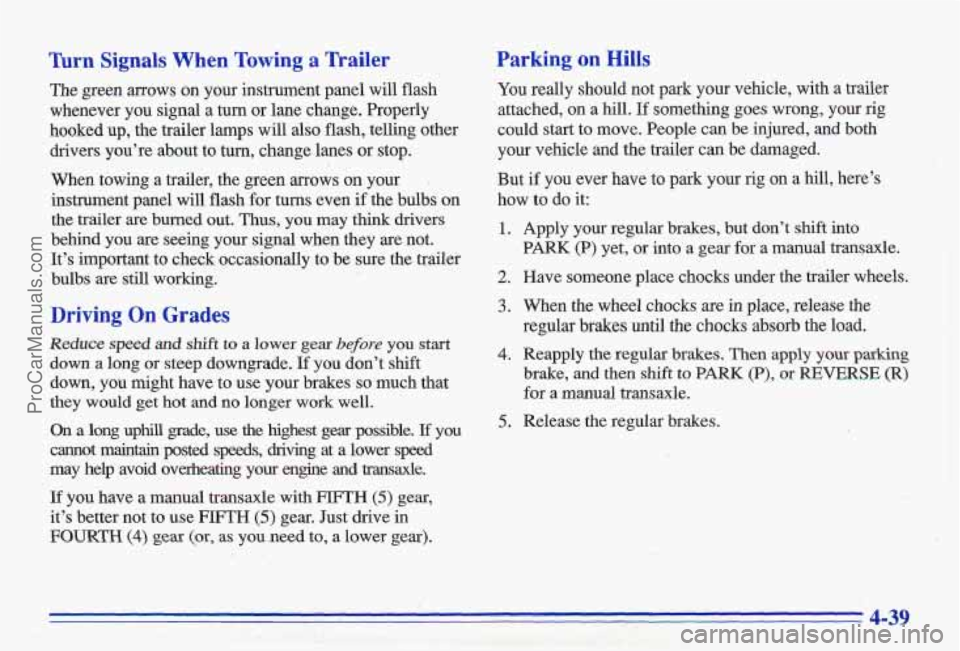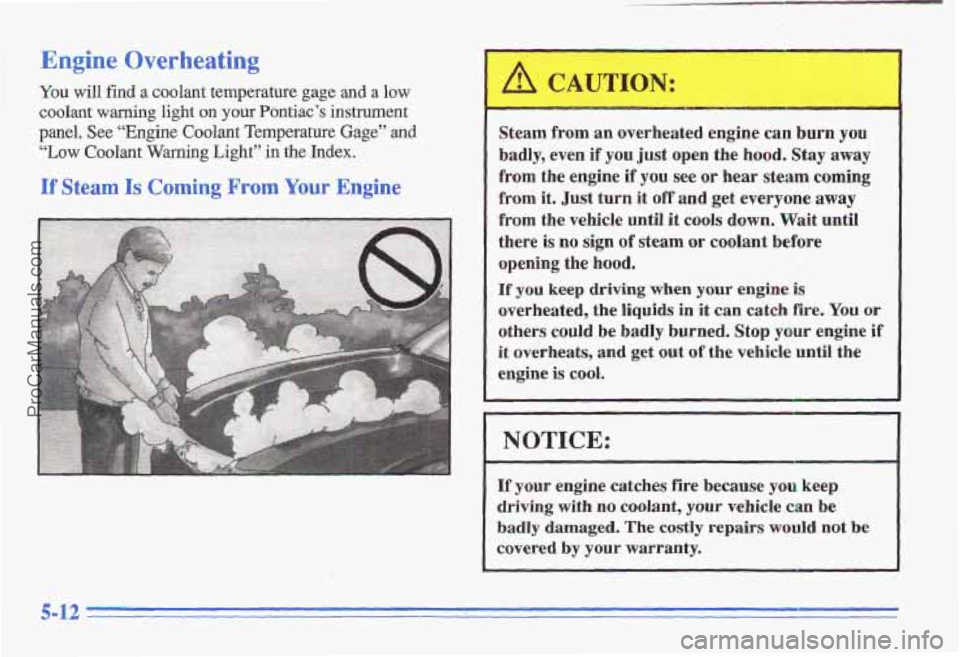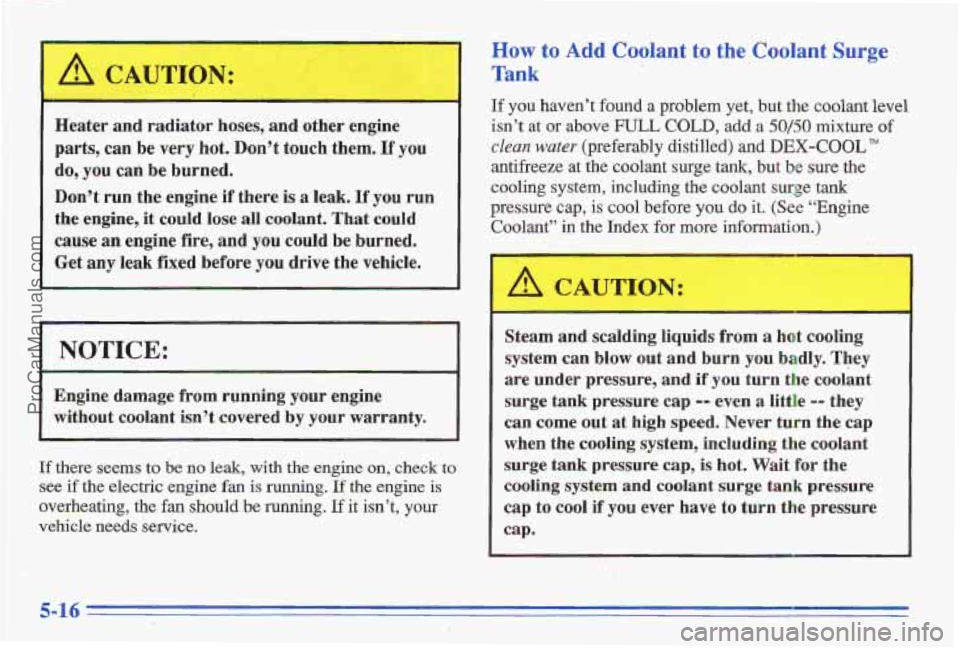1996 PONTIAC GRAND-AM overheating
[x] Cancel search: overheatingPage 115 of 356

Enhanced Traction System Active Light
LOW
TRAC
When your Enhanced Traction System is limiting wheel spin, this light will
come on. Slippery road
conditions may exist
if the
Enhanced Traction System
active light comes on,
so
adjust your driving
accordingly.
The light
will stay on for a few seconds after the
Enhanced Traction System stops limiting wheel spin.
The Enhanced Traction System active light also comes
on briefly when you turn the ignition key to RUN. If the
light doesn’t come on then, have it fixed
so it will be
there to tell you when the system is active.
Engine Coolant Temperature Gage
This gage shows the engine
coolant temperature.
If the
gage pointer moves into the
red area,
your engine is too
hot!
A light will come on to the right of the gage when the
gage pointer moves beyond the normal operating zone.
It means that
your engine coolant has overheated.
If you have been operating your vehicle under normal
driving conditions, you should pull
off the road, stop
your vehicle and turn off the engine as soon as possible.
In “Problems on the Road,” this manual shows what to
do. See “Engine Overheating” in the Index.
2-59
ProCarManuals.com
Page 116 of 356

Low Coolant Warning Light
; I’ ,.
If this light comes on and
stays on, the vehicle should
be promptly pulled
off the
road and the coolant level
checked.
See “Engine
Coolant”
in the Index.
Malfunctilon Indicator Lamp
(Check Engine Light) ~ ..
0
CHECK
Your Pontiac is equipped
with a computer
which
monitors operation of the
fuel, ignition and emission
control systems.
If there are visible signs of steam see “Engine
Overheating” in the
Index before opening the hood. , . ’? --+ -- This system is called OBD I1 (On-Board .>. ’ I .;: . , Diagnostics-Second Generation) and is intended to
.-. . assure that emissions are at acceptable levels for the
life of the vehicle, helping to produce a cleaner
environment.
(In! Canada, OBD 11 is replaced by
Enhanced Diagnostics.) The CHECK ENGINE light
comes on to indicate that there is a problem and service
is required, Malfunctions often will
be indicated by the
system before
any problem is apparent, which may
prevent more serious damage to your vehicle. This
system is
also designed to assist your service technician
d . in correctly diagnosing any malfunction.
.. .? ’. .. .- . .. i - ,, , c < -. , ,. t :. . ‘7 -n. 9’ .! , . ‘i :- -:x: :, -’ ::;.- . b- .. ,- , . .. .. . : .. -. I. . :. ‘1 .’ ’ E -, . - . r_ :. .. . I. , I -.. . I .C . .. . . .. . .-..-‘ >: =: , , ‘. .. -; T‘.
’ ““2-60
ProCarManuals.com
Page 187 of 356

Turn Signals When Towing a Trailer
The green arrows on your instrument panel will flash
whenever you signal a turn or lane change. Properly
hooked up, the trailer lamps
will also flash, telling other
drivers you’re about to
turn, change lanes or stop.
When towing a trailer, the green arrows
on your ’.
instrument panel will flash for turns even if the bulbs on
the trailer are burned out. Thus, you may think drivers
behind you are seeing your signal when they are not.
It’s important to check occasionally to be sure the trailer
bulbs are still working.
Driving On Grades
Reduce speed and shift to a lower gear before you start
down a long or steep downgrade. If you don’t shift
down, you might have to use your brakes
so much that
they would
get hot and no longer work well.
On a long uphill grade, use the highest gear possible. If you
cannot maintain posted speeds, driving at a lower speed
may help avoid overheating your engine and bxmsaxle.
If you have a manual transaxle with FWTH (5) gear,
it’s better not to use
FIFTH (5) gear. Just drive in
FOURTH (4) gear (or- as vou need to, a lower gear).
Parking on Hills
You really should not park your vehicle, with a trailer
attached, on a
hill. If something goes wrong, your rig
could start to move. People can be injured, and both
your vehicle and the trailer can be damaged.
But if you ever have to park your rig on a hill, here’s
how to
do it:
1.
2.
3.
4.
5.
Apply your regular brakes, but don’t shift into
PARK (P) yet, or into a gear for a manual transaxle.
Have someone place chocks under the trailer wheels. When the wheel chocks are in place, release the
regular brakes until the chocks absorb
the load.
Reapply the regular brakes. Then apply your
parking
brake, and then shift to PARK (P), or REVERSE (R)
for a manual transaxle.
Release the regular brakes.
4-39
ProCarManuals.com
Page 202 of 356

Engine Overheating .
You will find a coolant temperature g.age and a low
coolant warning light on your Pontiac’s instrument
panel. See
“Engine Coolant Temperature Gage” and
“Low Coolant Warning Light” in the Index.
If Steam Is Coming From Your Engine
Steam from an overheated engine can burn you
badly, even if you just open the hood. Stay away
from the engine if you
see or hear steam coming
~ from it. Just turn it off and get everyone away
from the vehicle until it cools down. Wait until
there
is no sign of steam or coolant before
opening the
hood,
If you keep driving when your engine is
overheated, the liquids in it can catch fire, You or
others could
be badly burned. Stop your engine if
it overheats, and get out of the vehicle until the
engine is cool.
1 NOTICE:
~ ~~
If your engine catches fire because you keep
driving with no coolant, your vehicle can be
badly damaged. The costly repairs would not be
covered by your warranty.
5-12
ProCarManuals.com
Page 206 of 356

6!!l CAUTION:
~~~ ~
Heater and radiator hoses, and other engine
parts, can be very hot. Don’t touch them.
If you
do, you can be. burned.
Donst run the engine
if there is a leak. If you run
the engine, it could
lose all coolant. That coulld
cause an engine
fire, and you could be burned.
Get
any leak fixed before you drive the vehicle.
without coolant isn’t covered
by your warranty.
If there seems to be no leak, with the engine on, check to
see if the electric engine fan is running. If the engine is
overheating, the fan should be running. If it isn’t, your
vehicle needs service.
How to Add Coolant to the Coolant Surge
Tank
If you haven’t found a problem yet, but the coolant level
isn’t at
or above FULL COLD, add a 50150 mixture of
clean water (preferably distilled) and DEX-COOL
antifreeze at the coolant surge tank, but be sure the
cooling
system, including the coolant surge tank
pressure cap,
is COO^ before you do it, (See “Engine
Coolant” in the Index for more infomati .) - --
I
Steam and scalding liquids from a hot cooling
system can blow out and burn you badly. They
are under pressure, and
if you turn the coolant
surge tank pressure cap
-- even a little -- they
can come out at high speed. Never turn the cap
when the cooling
system, including the coolant
surge tank pressure
cap, is hot. Wait for the
cooling system and coolant
surge tank pressure.
cap to cool if you ever have to turn the pressure
cap.
5-16
ProCarManuals.com
Page 244 of 356

When to Check and What to Use
Refer to the Maintenance
Schedule
to determine how
often you should check the
fluid level
in your clutch
master cylinder reservoir and for
the proper fluid.
See “Owner Checks
and Services” and
“Recommended Fluids
and Lubricants” in the
How tu Check
The proper fluid should be added if the level is at or
below the
STEP mark on the reservoir cap. See the
instructions
on the reservoir cap.
Engine Coolant
The cooling system in your vehicle is filled with new
DEX-COOL TM (orange-colored, silicate-free) engine
coolant.
This coolant is designed to remain in your
vehicle
for 5 years or 100,000 miles (166 000 h),
whichever occurs first. The
following explains
your cooling system and how to
add coolant when it is low. If you have a problem with
engine overheating, see “Engine Overheating”
in the
Index.
A Sol50 mixture of water and the proper coolant for
your Pontiac will:
Give freezing protection down to -34°F (-37°C).
Give boiling protection up to 265 9 F ( 129 O C).
Protect against rust and corrosion.
0 Help keep the proper engine temperature.
Let the warning lights and gages work as they
should.
6-22
ProCarManuals.com
Page 248 of 356

Surge Tank Pressure Cap
NOTICE: ~~ ~
Your pressure cap is an 15 psi l(105 kPa)
pressure-type cap and must be tightly installed to
prevent coolant loss and possible engine damage
from overheating,
When you replace your surge tank pressure cap, a GM
cap is recommended.
Thermostat
Engine coolant temperature is controlled by a thermostat
in the engine coolant system, The thermostat stops the
flow of coolant through the radiator until the coolant
reaches
a preset temperature.
When you replace your thermostat,
an AC@ thermostat
is recommended.
Power Steering Fluid
When to Check Power Steering Fluid
It is not necessary to regularly check power steering
fluid unless
you suspect there is a leak in the system or
you hear an unusual noise. A fluid loss in this system
could indicate a problem. Have the system inspected
and
repaired.
6-26
ProCarManuals.com
Page 259 of 356

Replacement blades come in different types and are removed in different ways. Here’s how to remove the
type with a release clip:
1. Pull the windshield wiper am away from the ‘
2. Lift the release clip with a screwdriver and pull the
3. Push the new wiper blade securely on the wiper arm.
For the proper type and size, see “Capacities and
Specifications”
in the Index.
windshield.
blade assembly
off the wiper arm.
Tires
We don’t make tires. Your new Pontiac comes with
highquality tires made by a leading tire manufacturer. If
you ever have questions about your tire warranty and
where to obtain service, see your Pontiac Warranty
booklet for details.
.-
Poorly maintained and improperly used tires are
dangerous.
Overloading your tires can cause
overheating as
a result of too much friction.
You could have an air-out and a serious
accident. See “Loading Your Vehicle” in the
Index.
Underinflated tires pose the same danger as
overloaded tires. The resulting accident
could cause serious injury.
Check all tires
frequently
to maintain the recommended
pressure. Tire pressure should be checked
when your tires are cold.
Overinflated tires are more likely
to be
cut, punctured or broken
by a sudden
impact
-- such as when you hit a pothole.
Keep tires at the recommended pressure.
Worn, old tires can cause accidents.
If your
tread is badly worn, or
if your tires have
been damaged, replace
them.
6-37
ProCarManuals.com